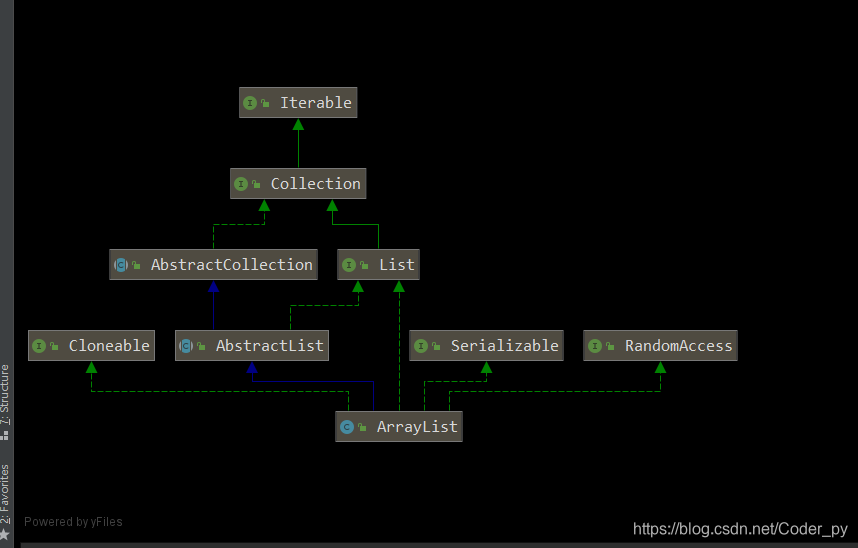一、ArrayList介绍
(1)ArrayList是基于数组实现的集合类。
(2)ArrayList是属于线程不安全集合,如果多线程对同一个ArrayList进行操作时,要额外进行同步操作。
(3)ArrayList的继承关系图

二、ArrayList源码分析
2.1 类属性
//序列号
private static final long serialVersionUID = 8683452581122892189L;
//默认初始容量
private static final int DEFAULT_CAPACITY = 10;
//空的对象数组
private static final Object[] EMPTY_ELEMENTDATA = {};
//默认空对象数组
private static final Object[] DEFAULTCAPACITY_EMPTY_ELEMENTDATA = {};
//存放集合元素的数组
transient Object[] elementData;
//集合的大小(里面包含的元素)
private int size;
//能够分配的最大数组容量
private static final int MAX_ARRAY_SIZE = Integer.MAX_VALUE - 8;
2.2 构造方法
ArrayList一共有三个构造方法:

(1)无参构造函数:
/**
* Constructs an empty list with an initial capacity of ten.
*(构造一个空的list,初始容量是10)
* ArrayList存放元素的其实就是数组elementData
*/
public ArrayList() {
this.elementData = DEFAULTCAPACITY_EMPTY_ELEMENTDATA;
}
(2)有参构造方法一:
/**
* Constructs an empty list with the specified initial capacity.
* (构造一个空的list,容量大小为给定参数大小)
*
* @param initialCapacity the initial capacity of the list
* @throws IllegalArgumentException if the specified initial capacity
* is negative
*/
public ArrayList(int initialCapacity) {
if (initialCapacity > 0) {
this.elementData = new Object[initialCapacity];
} else if (initialCapacity == 0) {
this.elementData = EMPTY_ELEMENTDATA;
} else {
throw new IllegalArgumentException("Illegal Capacity: "+
initialCapacity);
}
}
(3)有参构造方法二:
/**
* Constructs a list containing the elements of the specified
* collection, in the order they are returned by the collection's
* iterator.
*
*(把一个集合里面的所有元素转移的当前ArrayList中)
* @param c the collection whose elements are to be placed into this list
* @throws NullPointerException if the specified collection is null
*/
public ArrayList(Collection<? extends E> c) {
elementData = c.toArray();//转换成数组
if ((size = elementData.length) != 0) {
// c.toArray might (incorrectly) not return Object[] (see 6260652)
if (elementData.getClass() != Object[].class)
elementData = Arrays.copyOf(elementData, size, Object[].class);
} else {
// replace with empty array.
this.elementData = EMPTY_ELEMENTDATA;
}
}
2.3 核心方法
2.3.1 add方法
/**
* Appends the specified element to the end of this list.(把给定元素添加到list的末尾)
*
* @param e element to be appended to this list
* @return <tt>true</tt> (as specified by {@link Collection#add})
*/
public boolean add(E e) {
//size为原来list里面元素的个数,因为添加了一个,所以要加 1,ensureCapacityInternal函数用来判断size+1这个大小数组还能不能放的下
ensureCapacityInternal(size + 1); // Increments modCount!!
elementData[size++] = e;//在合适的位置插入元素,size+1
return true;
}
ensureCapacityInternal方法
private void ensureCapacityInternal(int minCapacity) {
//看当前数组是否为空的数组,如果是就把minCapacity设置为默认容量10
if (elementData == DEFAULTCAPACITY_EMPTY_ELEMENTDATA) {
minCapacity = Math.max(DEFAULT_CAPACITY, minCapacity);
}
ensureExplicitCapacity(minCapacity);
}
ensureExplicitCapacity方法
rivate void ensureExplicitCapacity(int minCapacity) {
modCount++;
// overflow-conscious code
//如果minCapacity大于数组长度,就说明数组的空间不够用了,就需要扩容
if (minCapacity - elementData.length > 0)
grow(minCapacity);//关键的扩容函数
}
grow方法
/**
* Increases the capacity to ensure that it can hold at least the
* number of elements specified by the minimum capacity argument.
*
* @param minCapacity the desired minimum capacity
*/
private void grow(int minCapacity) {
// overflow-conscious code
int oldCapacity = elementData.length;//扩容前数组大小给oldCapacity,代表了旧的数组大小
int newCapacity = oldCapacity + (oldCapacity >> 1); //对oldCapacity扩容1.5倍,然后给newCapacity,代表新的数组大小
if (newCapacity - minCapacity < 0) //如果扩容后的新的数组大小还不足以放下minCapacity大小的元素,就让newCapacity等于minCapacity
newCapacity = minCapacity;
if (newCapacity - MAX_ARRAY_SIZE > 0)//如果扩容后的新的数组大小比最大容量值还大,就调用hugeCapacity函数,把能给到的最大值给newCapacity
newCapacity = hugeCapacity(minCapacity);
// minCapacity is usually close to size, so this is a win:
elementData = Arrays.copyOf(elementData, newCapacity);//容量确定好后就把数组里面的元素迁移复制过去
}
2.3.2 remove方法
/**
* Removes the element at the specified position in this list.
* Shifts any subsequent elements to the left (subtracts one from their
* indices).移除给定位置的元素,把剩余元素全体往左移动
*
* @param index the index of the element to be removed
* @return the element that was removed from the list
* @throws IndexOutOfBoundsException {@inheritDoc}
*/
public E remove(int index) {
rangeCheck(index);//检查索引是否越界
modCount++;
E oldValue = elementData(index);//获取待删除元素
int numMoved = size - index - 1;//删除指定元素后其余元素需要移动的位数
if (numMoved > 0)
System.arraycopy(elementData, index+1, elementData, index,
numMoved);
elementData[--size] = null; // clear to let GC do its work
return oldValue;
}
removeAll方法
/**
* Removes from this list all of its elements that are contained in the
* specified collection.(从list里面移除集合c里面含有的元素)
*
* @param c collection containing elements to be removed from this list
* @return {@code true} if this list changed as a result of the call
* @throws ClassCastException if the class of an element of this list
* is incompatible with the specified collection
* (<a href="Collection.html#optional-restrictions">optional</a>)
* @throws NullPointerException if this list contains a null element and the
* specified collection does not permit null elements
* (<a href="Collection.html#optional-restrictions">optional</a>),
* or if the specified collection is null
* @see Collection#contains(Object)
*/
public boolean removeAll(Collection<?> c) {
Objects.requireNonNull(c);//检查集合c是否为空
return batchRemove(c, false);//进行统一移除
}
private boolean batchRemove(Collection<?> c, boolean complement) {
final Object[] elementData = this.elementData;//复制一份原始数据出来
int r = 0, w = 0;
boolean modified = false;
try {
for (; r < size; r++)//对数组进行遍历,检查集合c中的元素是否也出现在list里面(参数可为false与true)
if (c.contains(elementData[r]) == complement)
elementData[w++] = elementData[r];
} finally {
// Preserve behavioral compatibility with AbstractCollection,
// even if c.contains() throws.
if (r != size) {//把符合要求的元素复制过去
System.arraycopy(elementData, r,
elementData, w,
size - r);
w += size - r;
}
if (w != size) {//把移动元素之后没用的元素清空,让垃圾回收器进行处理
// clear to let GC do its work
for (int i = w; i < size; i++)
elementData[i] = null;
modCount += size - w;
size = w;
modified = true;
}
}
return modified;
}





 该博客主要介绍了Java中的ArrayList,它是基于数组实现的集合类,线程不安全,多线程操作需额外同步。还对ArrayList进行了源码分析,包括类属性、三个构造方法,以及add、remove等核心方法和相关辅助方法。
该博客主要介绍了Java中的ArrayList,它是基于数组实现的集合类,线程不安全,多线程操作需额外同步。还对ArrayList进行了源码分析,包括类属性、三个构造方法,以及add、remove等核心方法和相关辅助方法。
















 1039
1039

 被折叠的 条评论
为什么被折叠?
被折叠的 条评论
为什么被折叠?








